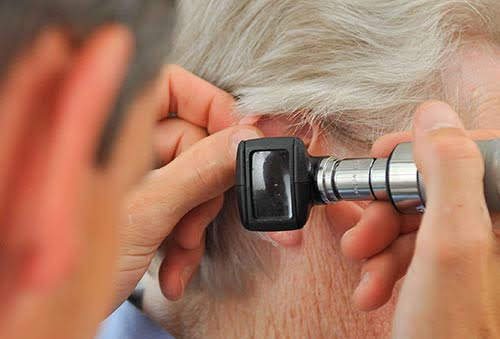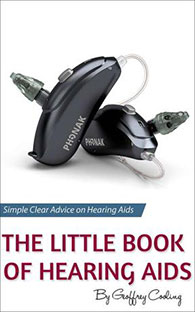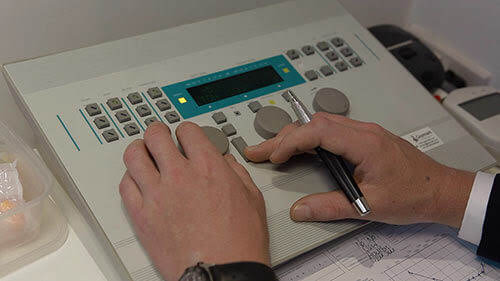Hearing Tests in The UK & Ireland
What Happens During the hearing test?
What are the hearing tests and what do they tell us?
Hearing Tests, What Happens At Them?
Many people get a little worried before a hearing test, there is no real need to. It is usually the fear of the unknown, the word test also doesn't help. It conjures up images from school days that many would prefer to forget. A better word is assessment because that is what the procedure is. An evaluation of your hearing system and your ability to hear. It is not a test that you pass or fail. Let's talk about the hearing test, we will explain what each test is and what information it gives.
Looking For The Latest Hearing Aid Technology or a Hearing Test?
Find a trusted Independent Hearing Care Professional in your area
The Hearing Test
The hearing test appointment will usually last about one and a half hours. The test is made up of several different parts that allow a professional to understand the background to any hearing loss. Any medical issues pertaining to your hearing and then your ability to hear. Each part of the process is designed to furnish different information. After the hearing test is complete, the professional will explain precisely what he or she has found and will make recommendations on those findings.
What happens during the hearing test?
Generally, the hearing test no matter where you get it will follow the same pattern with similar components. Components within the overall parts may differ based on who is providing the test and the results they are getting. For instance, some professionals may not undertake speech in noise tests at all, and middle ear testing may not be undertaken unless something points to it being specifically required. The hearing test will usually include:
- Examination of the ear and auditory canal, including video otoscopy
- Case history
- Full audiometric hearing assessment that will include pure tone testing, middle ear testing and possibly speech testing in quiet and noise.
- Explanation and discussion of outcome
- Impartial advice on the most suited hearing system for your requirements
Let's talk about those stages in more depth.
Otoscopy (Examination of the ear)

This part of the assessment is about the health of your ear, your outer ear and your ear canal. The professional will first examine the outside of your ear using a light. They are looking for any blemishes strange marks or sore spots. They will then use an instrument called an otoscope to examine your ear canal and your tympanic membrane (eardrum).
This again is to check the health of your canal and eardrum. They will check something called the light response on the eardrum, this is merely the way the light is reflected on the drum. A healthy tympanic membrane will reflect the light in a specific way. This examination may also give indications of problems with your middle ear and signs of any history of perforations. Once the professional is happy, they will move onto the next part.
Case History
A case history is taken to get an understanding of the background of your hearing loss. During the case history, they will ask you questions such as your name, address and date of birth. They will ask you about any treatments in the past that may have used ototoxic drugs (medicines that are toxic and damage hearing). Then the professional will ask you questions about any background to the hearing loss, such as your working history when you noted an issue if the issue occurred suddenly, has it worsened suddenly, do you have tinnitus, if so is it in only one ear etc.
These last few questions are designed to allow the professional to assess if you have what is called a referrable condition. If they find this to be so, they may well continue the test but will refer you on for further examination by an ENT professional. Once this is done the professional will also ask you questions about the perception that you have of the impact of your problem on your daily life. These questions are important because it allows the professional to begin to understand your lifestyle and the effect if any that hearing loss is having on it. After the case history is undertaken, they will move onto the auditory testing proper.
Auditory Testing
Auditory testing is made up of several tests that assess the full function of your auditory system. It is essential that the examination is comprehensive, but certain parts of the test may not be needed depending on results from earlier tests.
What happens during auditory testing?
As we said, not all tests may be undertaken, for instance, tympanometry may not be needed, however best practice auditory testing involves the following criteria;
- Pure tone testing (Audiometry)
- Speech in quiet testing
- Speech in noise testing
- Tympanometry
- Acoustic Reflex Threshold testing
- Distortion Product Otoacoustic Emissions (DPOAE) testing

Confused About The Right Hearing Aid For You?

Our buying guide, easing the confusion with clear easy to understand info, we guarantee it will help you pick the right hearing aid for you.
Audiometry ( Hearing Test)

Audiometry or pure tone testing is a series of tests where pure tones (sound like whistles and chirps) or warble tones (similar but they oscillate or vary) are presented through either headphones, insert earphones or a bone conduction headband. The results are plotted on an audiogram which shows your hearing sensitivity in the tested frequencies.
These tests tell us the softest sound that you can hear and allow us to tell you if your hearing sensitivity is within a normal range, or if there is a hearing loss. Audiometry results tell us many things beyond just your hearing sensitivity; it allows us to see if there is any asymmetry in your hearing loss ( a hearing sensitivity that is not equal between the two ears).
It also allows us to see the configuration of your hearing loss (the shape of the way your hearing loss occurs tell us a lot about your hearing loss causes) This and other tests can help towards a diagnosis of ear abnormalities.
How is audiometry performed?
The initial test involves you carefully listening through headphones that are placed over the ears or insert earphones that are placed in the ear canals. Pure tones will be presented through the headphones or insert earphones. This part of the test is called air conduction testing and is designed to allow the professional to assess what you can hear from the outer ear. If you hear the sound, you will push a button or raise your hand in response. The professional will continuously reduce the volume of the sound until you can no longer hear it. The key here is that the expert is trying to identify the softest sound you can hear, so no matter how quiet it is if you think you hear it you should push the button. Many people are never sure and feel like they are letting down the professional.
This couldn't be further than the truth, relax and don't get frustrated. Once the headphone or earphone test is undertaken, the professional will then change to a bone conduction vibrator on a headband that is placed behind the ear. This part of the test is designed to find out what your inner ear can hear, it is very rarely different, but in cases of conductive hearing loss, there will be a marked difference. This part of the test is essential, conductive hearing loss is a referrable condition, even if you know about it and an ENT has assessed it, the results are still necessary for the programming of any hearing aids that may be prescribed. This overall test will determine your hearing thresholds. Additional tests called masking may be added to the group of tests if an asymmetry of thresholds is found or if you have conductive hearing loss.
Speech Testing
Words will be presented at a comfortable listening level either free field which is presented through a calibrated speaker or through headphones. You will have to repeat the words, and the professional will score you on the results. This test gives the expert a deeper understanding of how you hear speech sounds, it also identifies the speech sounds you are missing. The analysis will then be undertaken with increasing levels of background noise. This test is an integral part of the assessment, it will give the professional a lot of information about how you perceive speech and the signal to noise ratio you need to hear and understand speech in noise.
Why is it important?
The level of sound you hear is only a starting point for our understanding of the impact of your hearing loss. This just tells us the mechanics of the sound levels. Speech testing actually allows us to understand how well the brain centres that manage hearing are working. It is often the case that speech scores can be radically different between two people, even if the audiogram results are the same. The speech in noise testing also allows us to understand what type of hearing aid technology level is most suitable for your hearing loss. For the best diagnosis and hearing aid recommendation, the speech testing protocol is a must.
How is speech testing performed?
Most independent hearing health professionals have updated their testing equipment to allow them to run automated speech and speech in noise tests through their audiometer. During these tests, you will be asked to repeat words that are presented to you at normal speech volume levels with and without noise. Word recognition scores will be determined and recorded on their system.
Middle Ear Analysis
What is middle ear analysis?
Middle ear analysis tests are undertaken to assess the function of the middle ear. The tests will determine how sound travels through your middle ear and also how your brain reacts to some sounds. You will feel a slight blocked sensation while a recording takes place. There are two parts to the Middle Ear Assessment: Tympanometry and Acoustic Reflexes.
Tympanometry
What is tympanometry?
It consists of measuring how much your eardrums are moving and if that movement is within normal limits. It tells us if there is any fluid or congestion behind the eardrums. (presence of fluid behind one’s eardrums is known as glue ear, and it is widespread in children). This test measures how well your middle ear works. Your middle ear includes your eardrum, the middle ear bones, and your Eustachian tube. It will reveal abnormalities which will signify and can explain a conductive hearing loss and/or a sensation of pressure in the ear.
How is tympanometry performed?
An ear tip is placed in the canal that is connected to a handheld machine; it briefly varies the pressure in the ear. By changing the pressure, the movement of the eardrum can be measured. It takes only a few minutes to complete. You will not need to respond during this test.
Acoustic Reflex Thresholds
What is acoustic reflex threshold testing?
When we hear a loud noise, our ear protects itself with a reflex which stiffens the eardrum. We use this reflex to test the Facial and Auditory nerves. This test measures how the stapedius muscle contracts in response to a loud sound. The absence or presence of acoustic reflexes can be important for differential diagnosis.
How is acoustic reflex threshold testing performed?
Often, tympanometry and acoustic reflex thresholds are done together. With the ear tip in your canal, you will hear beeps that are progressively louder. You will not need to respond. Instead, the machine will automatically measure the response.
Distortion Product Oto-acoustic Emissions (DPOAE)
What is DPOAE testing?
This test measures how well the outer hair cells in the cochlear work. The outer hair cells produce low-level sounds called Otoacoustic Emissions in response to clicks. A conductive or sensorineural hearing loss will often result in absent DPOAE responses.
How is DPOAE testing performed?
With an ear tip in the canal, clicks are presented in the ear. In response, the cochlear emits a sound which is recorded by the equipment. The extent of the response and the frequency at which the reaction occurs is measured and recorded.
Explanation of the results
Once the testing is complete, the professional will explain the results, they will tell what they have found and detail why it is having the impact it is in your life. They will also make recommendations based on their results for you to return to a more normal level of hearing and allow you to engage fully in your life.
Hearing Aid Benefit Assessment
If you are a suitable candidate for hearing aids, many professionals will then move onto a hearing aid benefit assessment or demonstration. In essence, what they will do is programme up a set of demo hearing aids to your loss, they will not give you full amplification but a level close to it. This will allow you a taste of what hearing aids sound like and how they will work. Any professional worth their salt will move through a demonstration of different features explaining to you as they go what they are and how they will work for you.
Looking For Hearing Aids or A Hearing Test?
We can arrange a consultation with a trusted Independent hearing healthcare professional in your area
